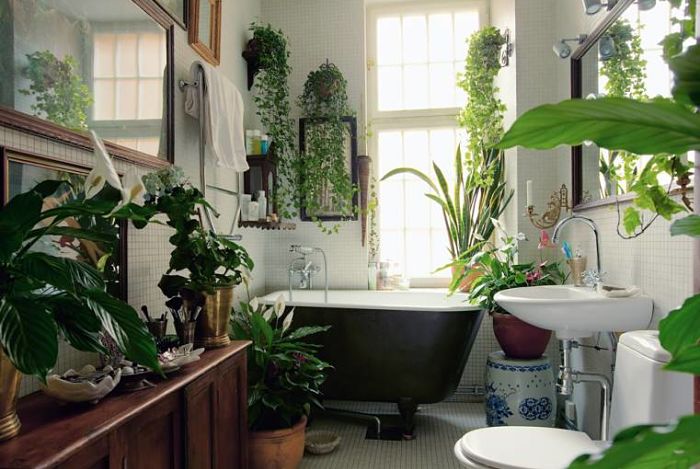Bathroom plants aren’t just for decoration. They also absorb organic pollutants from the air emitted by household items such as the stove / kitchen or detergents. The best options are spider plant, peace lily, and aloe vera, which remove carbon monoxide, benzene, and formaldehyde, respectively, from the air. Other options are Boston ferns and orchids. These 5 plants require little light, high humidity and minimal care, learn below how to take care of them and get the best out of them.
The 5 best bathroom plants you should have.
There are a wide variety of species that you can choose from, but here is a list to start with, of the plants that work especially well in bathrooms. These are tropical species and therefore happily live in the typically hot and humid environment of a bathroom.
How to select your bathroom plants?
Before selecting your plants, study the environment of the bathroom in terms of light, temperature, humidity and available space. Is your bathroom sunny or windowless? Is it extremely humid? Choose plants that will thrive in specific conditions.
Generally speaking, tropical plants with their need for low light, high humidity, and minimal care are ideal choices for bathroom plants. Space is another consideration: For a small bathroom, you should choose potted plants that can be placed on the windowsill or on the shelf. Alternatively, you can hang pots from the ceiling. If your bathroom has adequate floor space, tall floors add elegance and drama.
1. Aloe vera.
The ancient Egyptians called aloe vera ” the plant of immortality ” and that’s not a surprise, given what we know about its miraculous healing and nutritional properties. Aloe vera can also clean formaldehyde from the air in your home.
As a bath plant, aloe vera needs minimal care. Place it near a window that provides indirect light, water it sparingly, and just watches it unfold. It’s also good to have it in the bathroom if you run out of moisturizer or need to soothe an insect bite.
2. The spider plant.
The spider plant (Chlorophytum comosum) is a great option if you’re a newbie to indoor gardening or don’t have a lot of time to spare in plant care. It thrives in relatively cool temperatures. Moderate watering, well-drained soil, and indirect light are all this houseplant needs. Its growth is prolific. In the blink of an eye, the “mother” plant will produce baby spiders that you can use to multiply your family of spider plants.
3. Peace lilies.
The peace lily (Spathiphyllum) has glossy dark green leaves and white, waxy “flowers”; They are not really flowering but hooded leaf bracts that grow on top of the tiny flowers. True to its name, this tropical plant exudes serenity. It is popular as a home or office plant thanks to its ability to filter indoor pollutants like benzene.
Moderate or low light is sufficient for peace lilies; Keep in mind that the greater amount of light will result in the plant having more white “flowers”. Too much water can kill it. Water them moderately, about once a week, checking first to see if the top soil is dry. If the broad leaves get dusty, clean them or give your peace lily a quick shower. To ensure high humidity, give them a daily mist or place them near the bathroom area when taking a warm shower (avoiding contact with chemicals).
4. Orchids.
For an exotic spa environment in the bathroom, orchids are perhaps the ideal plants. Bright but indirect sunlight and high humidity levels mimic the orchid’s natural habitat. With their relatively small size and lack of foliage, orchids are a good choice for small bathrooms, adding a beautiful pop of color.
5. Boston ferns.
These bright green ferns (Nephrolepis exaltata) require cool temperatures, high humidity, and moderate and indirect lighting to thrive in a bathroom. Their bushy lushness makes them a good choice if bathroom space is not a limitation. Boston ferns tend to suffer if the air dries up. So, if your bath isn’t humid enough, spray the ferns with water intermittently.
Ferns are typically in peat pots or baskets. Give the basket a monthly soak and drain well afterward so the ferns stay well hydrated.









